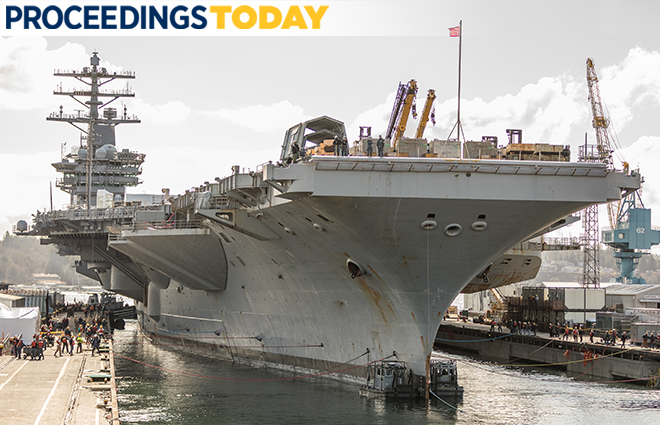
Earlier this year the USS Nimitz (CVN-68) entered Puget Sound Naval Shipyard for intermediate-level maintenence. (U.S. Navy photo.)
During the past year I have written several articles about naval aviation readiness and retention, and much is being done to reset the force in line with the 2018 National Defense Strategy and its focus on great power competition. Part of that reset involves a calculated reduction in deployments across the force. As USNI News reported last month, U.S. aircraft carrier deployments this year have been at a 25-year low, and there were 22 days in 2018 when no carriers were deployed at all. Some pundits might speculate what the Navy is up to, but overall there is good news and some key takeaways.
First, dynamic force employment (DFE) is an innovative Department of Defense (DoD) strategy to keep U.S. adversaries guessing. Historically, when U.S. carrier strike groups operate on the doorsteps of America's adversaries, they have been a powerful force to curb unwanted behaviors. Unfortunately, over the past three decades, the DoD got too predictable with how, when, and where it was deploying its forces, making it easy for adversaries to know how the United States would respond to aggression.
This year’s 22-day gap in carrier coverage was attributable to implementation of DFE. Even though the USS Harry S. Truman (CVN-75) returned home for a short break after the first three-months of her deployment in July, it was not because she required maintenance or lacked readiness. When Truman left the pier in April, she and her crew were trained and certified to operate uninterrupted for the entire planned deployment and beyond. They capable to leave for a hot spot at any point. The unusual deployment pause, in addition to operating in non-traditional areas, accomplished exactly what DFE was meant to—injecting unpredictability into the Navy’s operating patterns.
Building on the DFE concept, it is clear that the military’s geographic combatant commands (CoComs) needed to reinvent the way they have done business over the past three decades. After years of trying to meet incessant demands for forward deployed forces, the Navy hit the wall of unsustainability. Overutilization of forces contributes to degradation of readiness and morale; and while the Navy consistently answered the call, as resources were cut, the sailors, airframes, and hulls paid the price.
Blurring the historic lines of the CoComs is a great and necessary thing. Learning how to use forces flexibly and efficiently without sacrificing lethality benefits readiness, the budget, and unpredictability, ultimately leading to a strong and more effective fighting force.
The readiness shortfalls many have identified in the wake of the tragic 2017 ship collisions are the result of what I describe as well-intentioned decisions manifesting catastrophic consequences. While it was widely warned that the operational tempo of the past three decades would prove to be unsustainable, I do not believe senior military leaders intended to create the significant readiness and maintenance deficits the Navy is dealing with today.
Recovery, however, has to start somewhere, and it is encouraging that senior Navy and DoD leaders (and Congress) finally are buying the nuts and bolts, flight hours and steaming hours, and sailors needed to make the force whole again.
The recent interrupted deployment of the Harry S. Truman proves the Navy is serious about employing the force dynamically. At the same time, the low number of U.S. aircraft carrier deployments this year demonstrates the Navy also is serious about digging out of its readiness hole.
That being said, the most important, most dynamic and yet easiest piece to overlook in the Navy’s recovery, is the significance of the role that people will play. So much of the recovery rests on the shoulders of the men and women who maintain and operate the Navy’s ships, submarines, and aircraft. Just as the equipment has worn down, so have the Navy’s people been strained answering an increasing global demand with fewer and fewer resources and bodies.
While dynamic force employment provides an unpredictability advantage in battle, it brings added stress to the home front. Sailors’ families do not run on a dynamic force employment schedule—at least not intentionally. When was the last time a school took a week off to be “dynamic educators?” Not having a predictable family schedule may exacerbate some retention and recruitment challenges the Navy already faces.
Aircraft that cost $100 million and aircraft carriers that cost $13 billion only meet their full defense potential with experienced operators employing them and skilled maintainers and support personnel keeping them going. Every discussion of readiness and recovery must include the efforts—and their effectiveness—to recruit and retain skilled operators and maintainers where significant investments of both time and money already have been made.
Lieutenant Commander Kochanski is a Navy Selected Reservist assigned to the staff of Commander, Naval Air Forces, NAF at Naval Air Station North Island. He is also a commercial airline cargo pilot for an international logistics company. While on active duty he served as an expeditionary EA-18G pilot and a T-45C instructor pilot.


